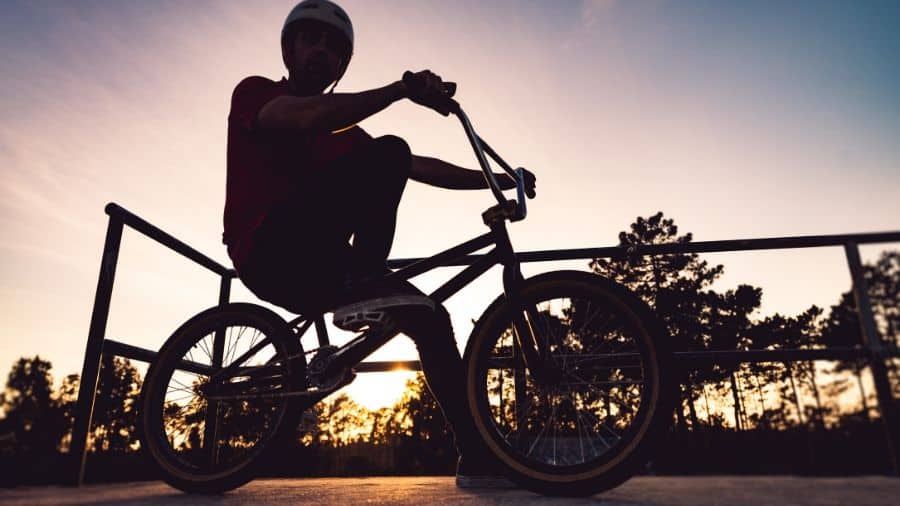
BMX riders dance their bikes in stunts that defy the laws of gravity. Can BMX bikes pedal backwards or is that another trick of the eye they’re able to dazzle onlookers with? I learned the hard and long way just how the masters manage this – and you’ll find out right here that its relatively easy to do too.
BMX pedals can go backwards, however, this will not cause the bike to move in a backwards direction – there is no reverse gear for BMX bikes. To perform certain tricks, such as the ‘fakie’, riders need their bikes to roll backwards. For this, cassette rear hubs enable BMX bikes to pedal backwards. These hubs allow the rider to maintain control over their bikes going forwards and backwards by turning the pedals either forwards or in reverse directions.
Don’t let the small frame size and wheels fool you into thinking BMX riding is only for youngsters and first-time cyclists. BMXing is one of the fastest-growing sports in the world where racers and freestyle riders are continually pushing the envelopes of speed and creativity for more outrageous tricks and stunts.
In fact, BMX racing and freestyle riding are now Olympic disciplines. A BMX bike pedaling backwards? That’s just one part of this exhilarating and addictive sport you’ve got to learn more about!
Table of Contents
What Makes BMX bikes pedal Backwards?
To understand just how BMX riders can pedal backwards, we’ll need to dip into some technical details to explain the mechanical magic going on with BMX bikes.
Movement on a bicycle is created when the rider pedals and rotates the crank. This engages the sprocket to drive the bike’s chain forward. The rear hub, located at the rear axle of the bike, is driven by the chain’s action that then turns the rear wheel forward through that transfer of the rider’s pedal-power to the rear hub.
So, the rear hub is a vitally important component of any bicycle – and especially so on a BMX.
Unlike road and mountain bikes, BMXes have only one fixed gear. This one gear is driven by the rear hub.
There are three main types of hubs used on BMX bikes:
- Coasters
- Freecoaster
- Cassette
Coaster hubs are mostly seen on entry-level BMXes and kids’ bikes, and function as backpedal brakes as soon as you stop pedaling.
Freecoaster hubs feature an intricate internal clutch system that allows the rider to ‘coast’ backwards without the cranks turning. Used mostly by Flatland riders, this hub system allows them to perform breakdancing tricks on their BMXes forwards or backwards in elaborate and mesmerising tricks. When you fakie on a freecoaster, you don’t have to pedal backwards.
Cassette hubs are essentially the same as you’re used to on a conventional road or mountain bike: it uses an independent cog fitted to the hub’s outer shell to drive the rear wheel forwards or backwards via the chain action and crank.
When the bike’s rear-wheel moves backwards, the pedals spin backwards too.
This is the hub system most preferred by BMX racers and freestyle riders for its simplicity and control it offers riders. When you fakie on a cassette, you have to pedal backwards, otherwise your gonna get stuck.
Why do BMX Riders Want to Pedal Backwards?
To better understand this question it’s important to know there are various disciplines of BMXing and each has distinct differences from the other.
To understand the different types of BMX riding, you’ll have to look at the roots of BMX.
In the early 1970s, BMX first started when kids raced their bicycles on motocross dirt tracks. In the hunt for more speed, riders fine-tuned and modified their bikes to the basic shape we know today. At the same time, riders were experimenting with their bikes in skateboarding parks.
This grew into freestyle and street riding disciplines. The styles of racing and freestyle bicycles overlapped, but each developed separate details in components used to suit their different types of riding.
BMX racing bikes must be super lightweight and stable over the jumps, through turns and when pedaling at full speeds, whereas freestyle and street riders aren’t interested in speeds but rather need their bikes to handle high jumps and hard landings.
BMX riding spread across the globe in the mid-1970s and took the world by storm in the 1980s and 1990s.
Freestyle riders push the envelope of what BMX bikes are truly capable. Taking on skateparks, streets and anything resembling grind rails, half- and quarter pipes, jumps, steps, and curbs loved by skateboarders, freestyle BMXers developed their bikes with smaller gears, stronger wheels, and removed the brakes from their bikes so that they not only withstand the punishment of heavy landings but also to allow them to perform ever more outrageous stunts.
Tricks were borrowed from surfing and skateboarding as riders mastered more and more stunts.
Spins, whips, walltops and grinds were are combined with sharp direction changes, hops, bounces and rails into complex techniques.
Pedalling backwards allowed the riders to transition into more tricks and stunts over obstacles, against walls and down half and quarter-pipes. As with skateboarding and surfing, they bent the laws of physics to perform awe-inspiring stunts.
Pedalling backwards allowed the riders to transition into more tricks and stunts over obstacles, against walls and down half- and quarter-pipes. As with skateboarding and surfing, they bent the laws of physics to perform awe-inspiring stunts.
What is a ‘Fakie’?
Freestlye BMX coined the ‘fakie’, a trick in which the rider maneuvers his bike backwards while facing forward.
Pedalling backwards and coasting backwards, the fakie added to the repertoire of tricks that freestyle BMXers innovatively used to interact with their environment.
Riding up walls at angles – called a wallride – or head-on to bounce onto the wall and then kick off it – called a walltop – allowed riders to push the limits of their sport and expand freestyle BMXing from skateparks to the streets and international attention.
This allowed another style of BMXing to gain in popularity: Flatlands BMX. Here, riders didn’t demand their bikes to be ruggedly tough or to jump over obstacles in high jumps but instead they performed tricks on their bikes akin to breakdancing in their fluidity, movement and artistic expression. Riding backwards, most often on one wheel, then transitioning into hops, spins and whips, grabs and more, secured the fakie and riding backwards into the pantheon of tricks of freestyle and flatlands BMX riders.
How to Fakie
If you’re a cyclist, you’ll know that riding forwards is pretty easy once you’ve mastered balancing on two wheels. Gravity and momentum carry us forwards when we pedal by steering and shifting our body’s weight. If bikes can ride backwards with pedalling thanks to cassette hubs, riding backwards is easy then?
Mastering BMX tricks can take many hours, days, weeks and months of practice.
To learn a fakie, good balance is key. Most newbies raise their seat post to a height that allows them to sit while pedalling, making learning fakies that bit easier – and once you’ve mastered this skill you can drop your seat height once more for better clearance.
The best place to practice is on an incline or small hill. By rolling your bike backwards down the hill, with your legs slowly turning the pedals in reverse, you’ll begin to grasp the engagement point of the cranks and the rear hub that allows rearward drive.
Regulating the amount of pressure you exert on the backwards pedalling action will control the speed of the reversing. By leaning backwards slightly and thereby shifting your weight over the back wheel, you’ll be able to counter steer the bike to maintain balance.
Once you’ve got the hang of that feeling, try riding backwards on a flat surface.
The best way to learn that is to leverage off an obstacle such as a curb or a wall. Ride slowly up to the chosen wall until your front wheel is level against it, then maintain your balance as you prop your bike against the wall.
Shift your body’s weight to the front wheel, and push off the wall once again using your body’s weight in a pivoting action. Gently shift your body’s weight back over the rear wheel to maintain greater balance and spin your pedals backwards to control the speed.
The more you practice, the greater your speed will become and the better your manoeuvrability of the BMX backwards. Even as a relatively new BMXer, you’ll be able to pedal your BMX backwards too!
